Disclaimer: This post contains affiliate links to handpicked partners, including tours, gear and booking sites. If you click through or buy something via one of them, I may receive a small commission. This is at no extra cost to you and allows this site to keep running.
This climbing Mt. Fuji hiking guide includes preparation tips, trek routes, overnight stays, and what to do if you don’t get to the summit.
Climbing Mount Fuji was more of an adventure than I had originally planned. Wedged snuggly between two locals within a sea of blue sleeping bags, I laid deadly still, having rehydrated and filled myself with painkillers in a desperate attempt to extinguish the migraine that was filling my pounding head. One hour later, I realised that I had succumbed to severe altitude sickness at 3,250 metres, which was soon marked by regular bouts of vomiting. One hour away from starting the 1 am ascent to the summit, the accomplishment of trekking Mount Fuji and standing atop the mountain was fading fast. I had to accept defeat.
Unable to walk very far and close to passing out after any strenuous movement, I requested my mountain house staff to get me down the mountain fast – the pain only worsened. When you’re an avid trekker, you learn to listen to your body and take the correct measures to protect yourself. This was that moment.
“The doctor is busy,” said the mountain house staff member. “You will have to wait for sunrise… and get down yourself.”
Nonetheless, the Mt Fuji hike and standing upon Japan’s famed peak and biggest natural wonders was a highlight of my trip. Here’s how you can experience climbing Fuji and successfully summit Japan’s highest peak.
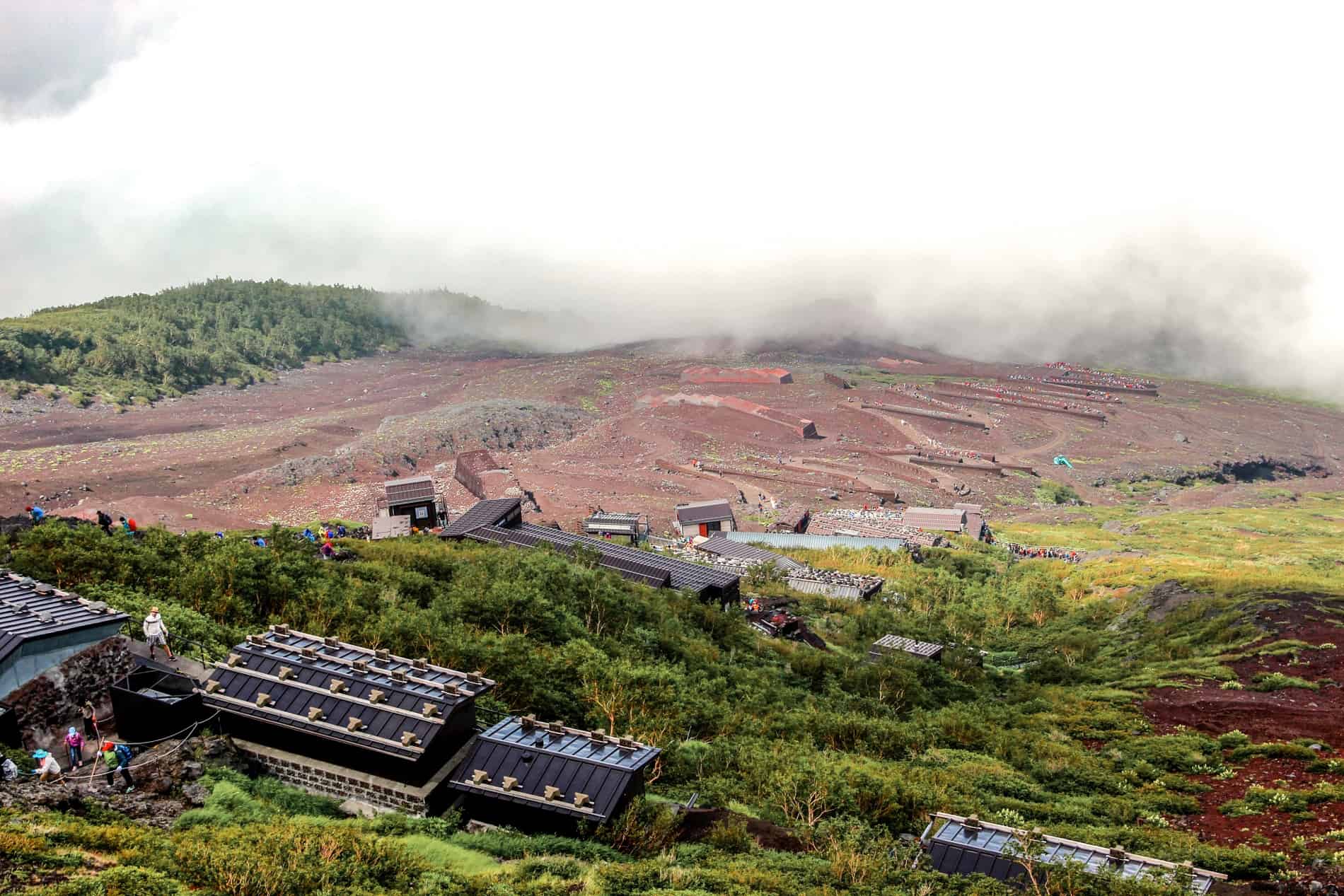
Climbing Mt. Fuji Hiking Guide – Top Tips For a Successful Summit
Contents
Climbing Mt Fuji Hike Guide FAQ
Mount Fuji is Japan’s highest and most photographed mountain, with an elevation of 3,776 metres. It’s also known as Fuji-san or Fujiyama.
Visible even from the Tokyo city skyline on a clear day, Fuji lures trekkers with her attractive symmetrical, snow-capped frame and promises of a glorious fiery-sky sunrise. Known to be not too difficult to hike, the small entry fee, and the fact you don’t need a guide, Fuji remains a popular commercial climb.
Fuji is also a sacred site, with many climbers as pilgrims on a special journey to the top of a peak given god-like status.
How much does it cost to climb Mt Fuji?
Mount Fuji was once free to climb. The donation-based entrance has since turned into a mandatory fee, helping to protect and maintain the trails. The climbing pass now costs around ¥1,000 – less than $10.
Buses from Kawaguchiko train station to the 5th Station cost 1,500 Yen one-way (Around $11).
A mountain hut for one night will cost around 5,500 Yen ($45) without food and 7,000 Yen ($55) including two meals (dinner and breakfast).
How long does it take to summit Fuji?
The average time spent on the trail climbing from the 5th Station to the summit and back down again is approximately 10 hours. This is discounting the time spent in the mountain hut resting.
Is Mount Fuji a volcano?
Fuji is an active volcano, although its last eruption was in 1707, so there is no immediate threat when hiking this great peak.
How difficult is the Mt Fuji hike?
The Mount Fuji hike isn’t considered difficult – it’s more a matter of stamina and how you react to altitude. There are no technical aspects to climbing Fuji, just long, zig-zagging pathways on rocky trails, many of which have safety barriers and paved ledges. Also, you do not hike Fuji starting at the foot of the mountain – the start of the trails at the 5th station reduces the overall length of the hike.
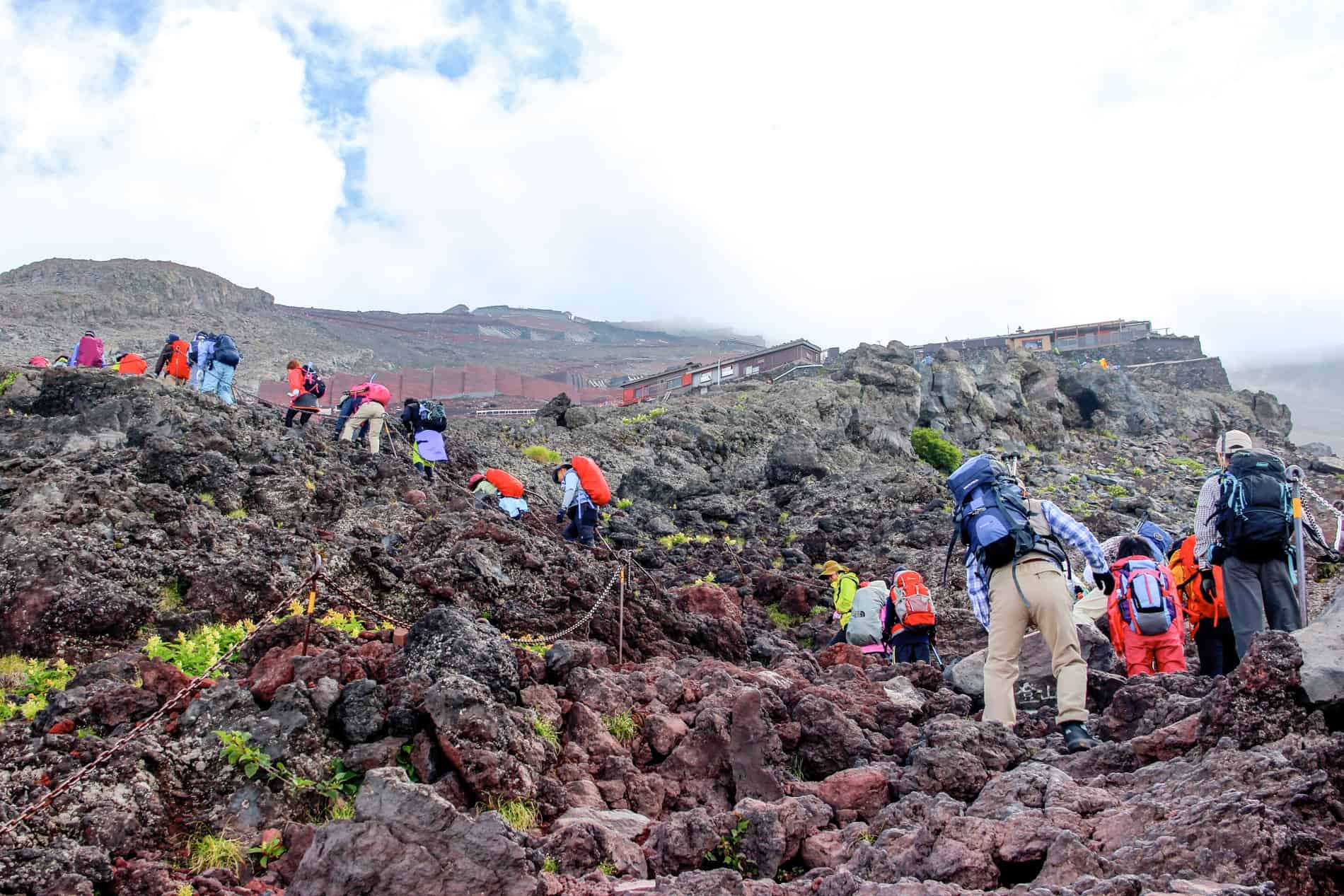
How difficult is it to hike Mt Fuji?
When is the best time to climb Fuji?
The best time to climb Mount Fuji is during the official climbing season, from early July to early September. This period is also the ‘no snow’ season, and climbing outside of this time is prohibited due to safety on the mountain with harsh weather conditions and the closure of mountain huts and other facilities. I hiked in August and found the climate comfortable.
Can you hike Mount Fuji without a guide?
Yes, you can. The majority of people climbing Fuji do so without a guide. You will never feel alone as the trail is always full. Just remember to pack everything you need, including layers, plenty of water, snacks, money and medications.
If you do not feel confident hiking Fuji alone, guides are available and will further ensure a successful summit. Ask your accommodation about recommended local guides.
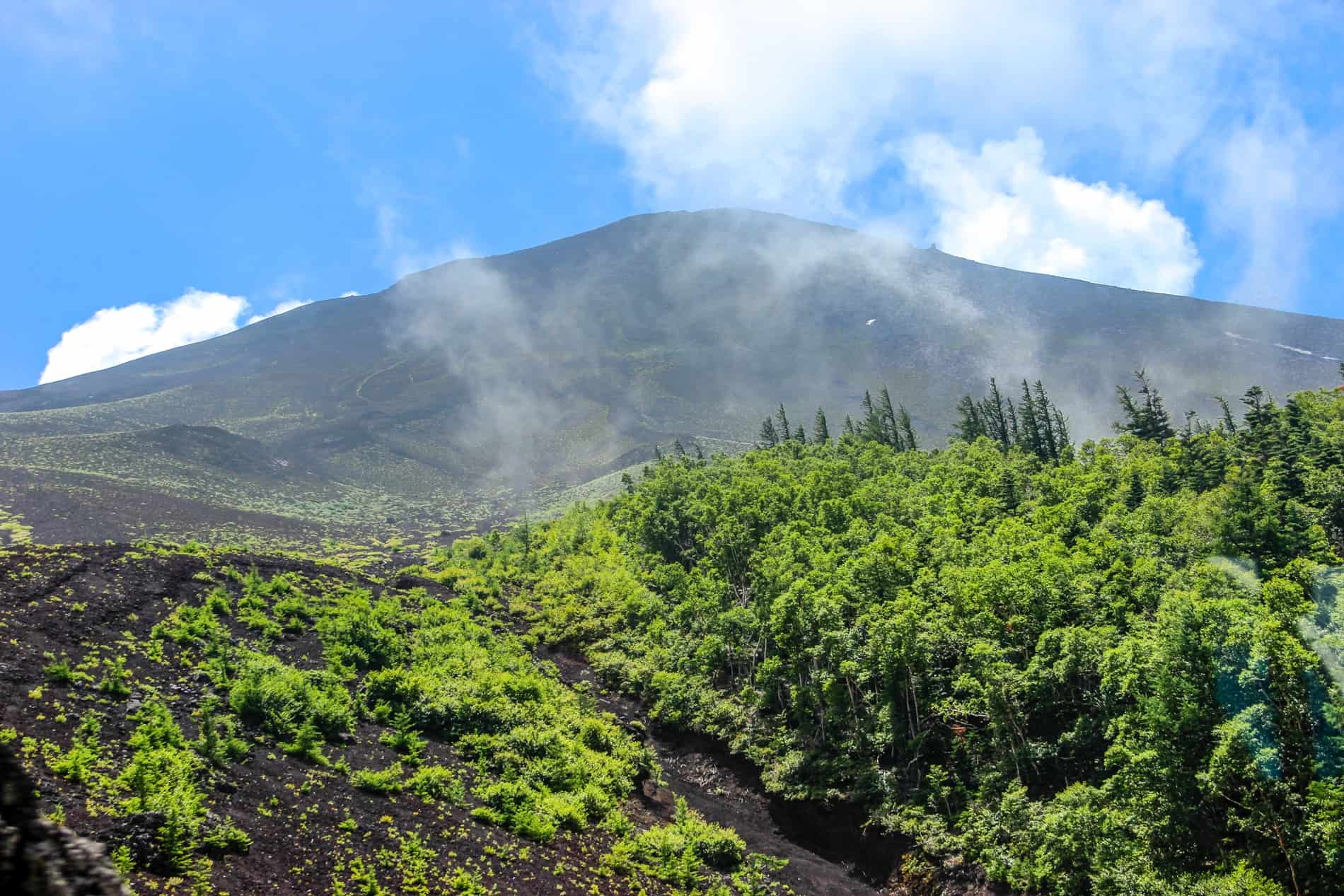
Approaching the mighty Mount Fuji on the way to the start point.
Preparing to Climb Mount Fuji
I like to be fully prepared when I climb a mountain, and the opinions of other climbers, not just locals, is crucial in getting things right. It’s not a situation where I am willing to take risks.
Where to stay before and after the hike
Many people come directly from Tokyo, but I was advised to travel a day or two beforehand and stay in the area, limiting the added exhaustion of an extra travel journey right before the hike.
The most popular and well-established place to stay is Lake Kawaguchiko in the Fuji Five Lakes region at the base of the mountain, alongside Lake Yamanakako, Lake Shojiko, Lake Saiko, and Lake Motosuko.
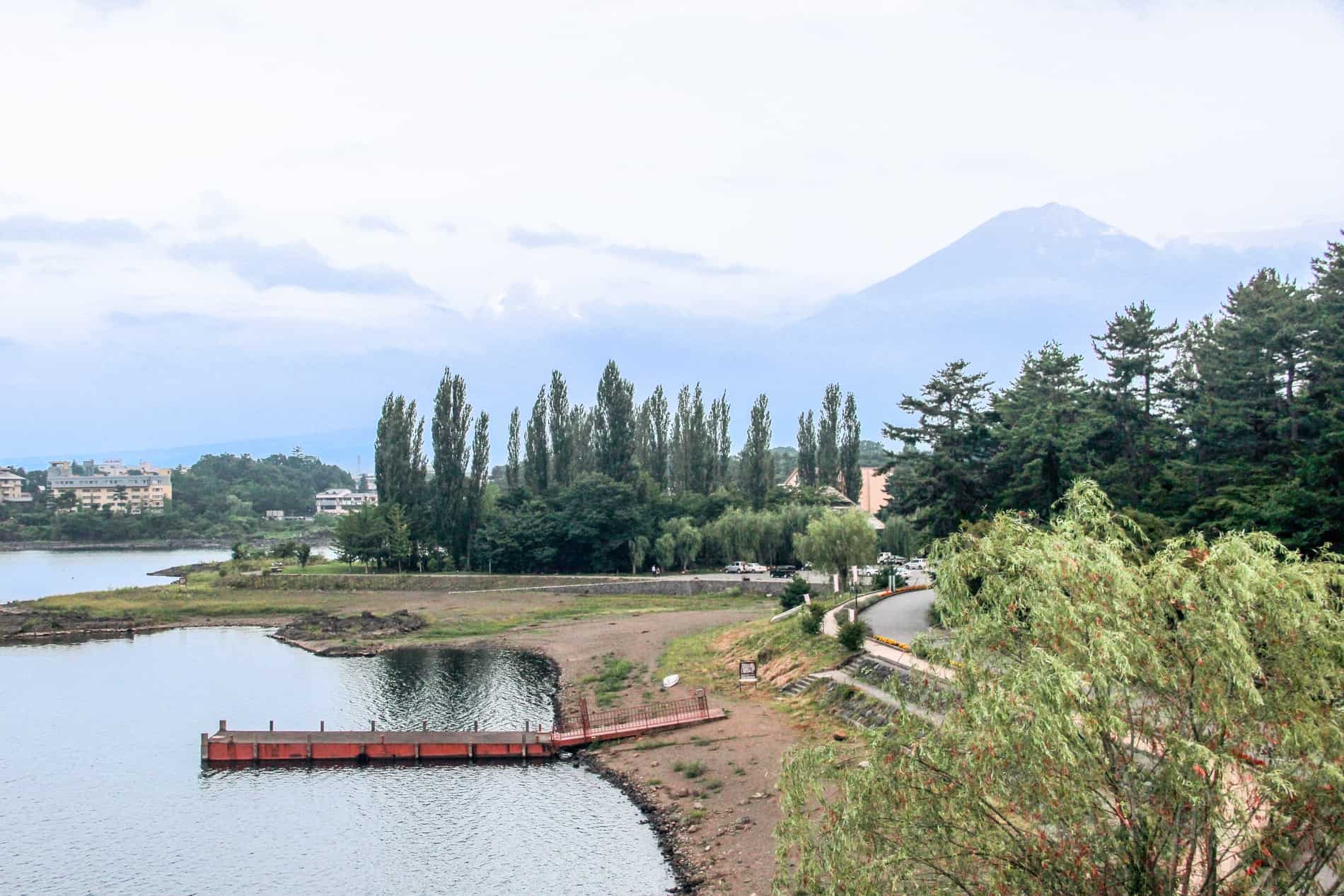
Lake Kawaguchiko in the Fuji Five Lakes region.
K’s House Traveller’s Hostel in Kawaguchiko has a great view of Mt. Fuji, complete with a scenic rooftop lounge. It has a mix of Japanese-style private rooms and modern-style dormitory rooms. Dorms start from €70. The nearby K’s House MtFuji has private rooms for €160.
Right in the heart of the Fuji area, it also caters for travellers eager for adventure. Not only were plenty of travellers willing to share their Fuji stories of trial and error, attempt and failure, or ‘I only came here to relax and look at the view,’ but the hostel was the information hub I needed – boards contained detailed information about the climb, the temperature and estimated times for sunrise was updated daily. The staff were always on hand to answer the many questions to help you prepare.
What to pack for Hiking Mt. Fuji
You’ll need to pack light for the Fuji hike as you will be carrying your bag, but you also need to bring the essentials for two days, including the overnight mountain hut stay. Consider a 25-30 litre hiking backpack with a 2-litre hydration bladder and take the following (most of which you will be wearing and not carrying as extra).
- Sturdy, already worn-in hiking boots or walking shoes with good grip for the volcanic, rocky and gravel terrain.
- Layers. Wear what you need and pack more to layer up for when it gets colder at altitude. A thermal base layer, a moisture-wicking t-shirt or long-sleeve top, a warm jacket or fleece and a windbreaker or down jacket.
- Pack waterproofs – pants and a waterproof jacket, because Fuji weather is unpredictable.
- Sunscreen and sunglasses. It may get foggy but don’t be fooled by the sun’s power on the Fuji climb.
- Headlamp for the early hours of the summit climb and use in the mountain hut.
- Minimal toiletries for the overnight stay.
- Medications – take your regular medications and get some Diamox in case of altitude sickness.
- Snacks like nuts and protein bars to last for approximately 10 hours of hiking time.
- Cash for extra snacks, drinks and meals. Credit cards are not accepted in most mountain huts.
Mt. Fuji Trails – Which One to Choose
The Fuji climbing experience isn’t too complicated – here’s where to start, what trail to choose, and what to expect from Japan’s famed pilgrimage hike.
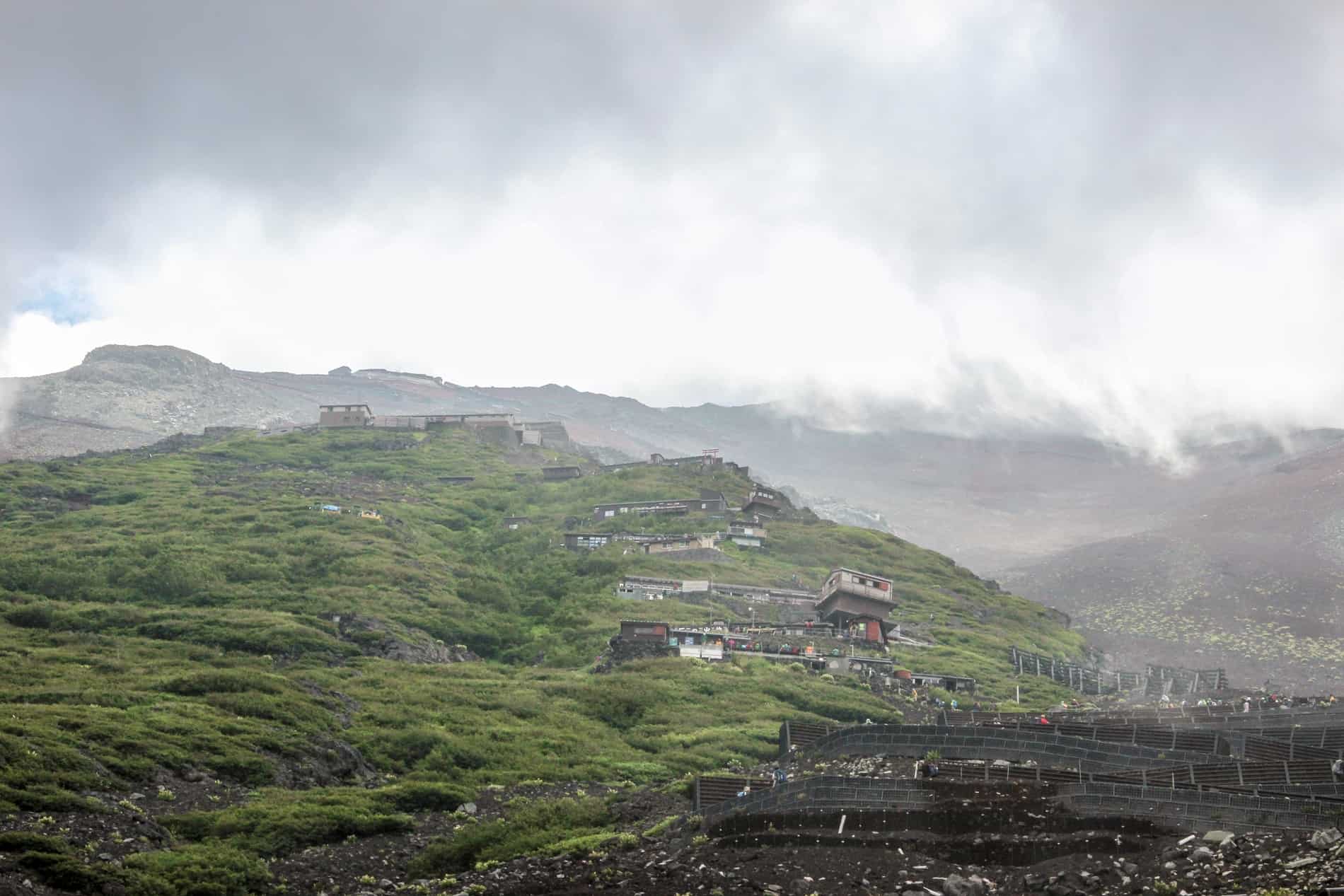
The climb up Mt. Fuji, passing station hut, rest points and lookouts. Which trail will you choose?
There are four main trails for climbing Mount Fuji: the Yoshida Trail, the Subashiri Trail, the Gotemba Trail, and the Fujinomiya Trail. Each has a varying level of difficulty regarding steepness and the type of terrain, and the trails are identifiable by their particular signage colour.
Each trail begins at the 5th Station of Fuji mountain. However, each trail has its own 5th Station location, so you must plan your arrival accordingly.
It is recommended to make reservations for mountain huts in advance of your trek.
Yellow: Yoshida Trail – Easiest and most popular
The easiest and most commercial path is the Yoshida Trail, with a zigzag mechanism of maintained paths, plenty of rest stops, and access to toilets and mountain huts. Ideally, start around midday at the 5th Station to reach the mountain house on the 8th Station after 3 PM for the overnight stay. You then sleep until it is time to begin the ascent to the summit (the 10th Station) in the early hours of the morning for sunrise after 4.30 AM.
- Ascent: 6 hours
- Decent: 4 hours (on a different path to the ascent trail)
Red: The Subashiri Trail – Relatively easy and less crowded
Another relatively easy Fuji path is the Subashiri Trail, which starts at the 5th Station. People often choose this route as it is less crowded than the Yoshida Trail, especially in peak seasons, and is considered to have a more beautiful approach on sloping paths. However, once you reach the 8th Station on the Subashiri Trail, the path to the 10th station summit is the same as that on the Yoshida trail.
- Ascent: 6 hours
- Decent: 4 hours (on a different path to the ascent trail)
Green: The Gotemba Trail – Longest and least trodden
The longest path up Fuji is the Gotemba Trail, which undoubtedly has the lowest footfall of all the trails as it winds up the mountain in a different direction. Due to its length and more rugged volcanic terrain, Gotemba is more difficult than the Yoshida and Subashiri trails. However, experienced hikers take this route because it has more scenic views at higher elevations.
- Ascent: 7 hours
- Decent: 3 hours (path of descent rejoins the path of ascent midway)
Blue: The Fujinomiya Trail – Steepest and most challenging
There’s always a steep and arduous path on every mountain, and Fujinomiya is just that. It may be the shortest of all Mt. Fuji trails, but it is a sharp and tough incline to the summit on challenging and rocky terrain. Despite being a busy route, it is not advisable for general everyday climbers to take this approach.
- Ascent: 5 hours
- Decent: 3 hours (on the same path of ascent)
Bullet Climbing – Fuji in One Day
There is an option to start your trek at 9 pm or 10 pm and climb through the night, reaching the summit for sunrise and making your way back down. This is known as Bullet Climbing and is not advised due to the dangers from exhaustion and falling rocks and trail accidents in the dark. You will notice signs at the 5th station advising against this method and doing so at your own risk.
There’s a third option, which is to traverse a much harder route that’s barely trodden, although it isn’t advised unless you are a more experienced hiker.
The 5th Station Starting Point
Depending on your trail, there are various routes to your designated 5th Station start point.
Greeted by swarms of people, who speckle the open space in a sea of bold colour, you soon get sucked into an atmosphere of nervous excitement as you begin your trek on flat ground.
Yoshida Trail 5th Station: Yamanashi Prefecture side
A one-hour mountain bus ride from Fujisan or Kawaguchiko train stations will bring you to the most well-known of Mount Fuji’s four 5th Station Fuji Subaru Line, standing at 2300 metres.
Subashiri Trail 5th Station: Shizuoka Prefecture side
Take the mountain bus from Gotemba or Shinmatsuda train stations to the Subashiri Trail 5th Station at 2000 metres.
Gotemba Trail New 5th Station: Shizuoka Prefecture side
Take the mountain bus from the Gotemba train station to the Gotemba Trail New 5th Station at 1450 metres.
Fujinomia Trail 5th Station: Shizuoka Prefecture side
Take a mountain bus from Mishima Station / Shin-Fuji Station, Fuji Station or Fujinomiya Station to the Fujinomia Trail 5th Station at 2400 metres.
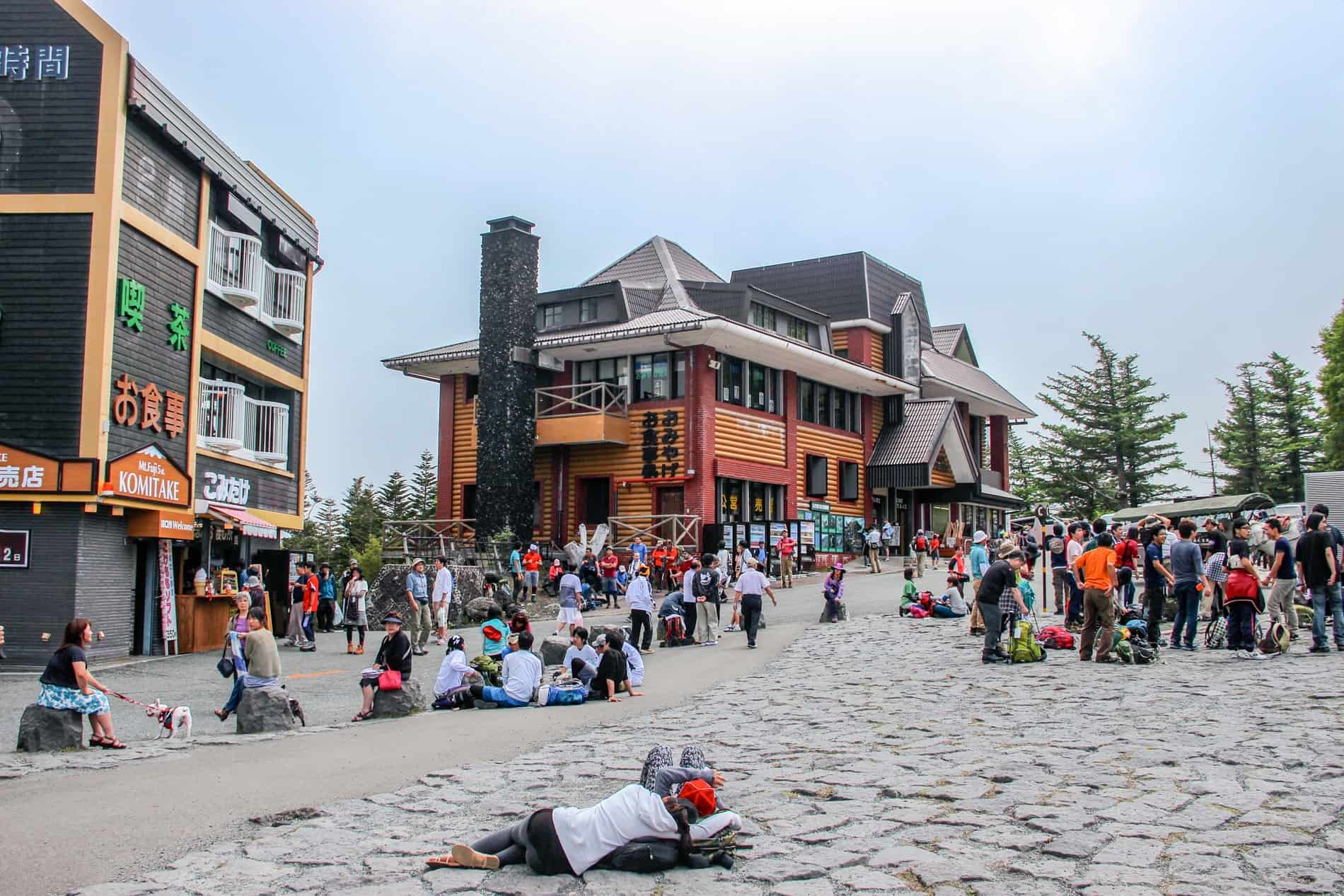
Hikers arrive at Mt Fuji’s 5th station to check in and begin the hike.
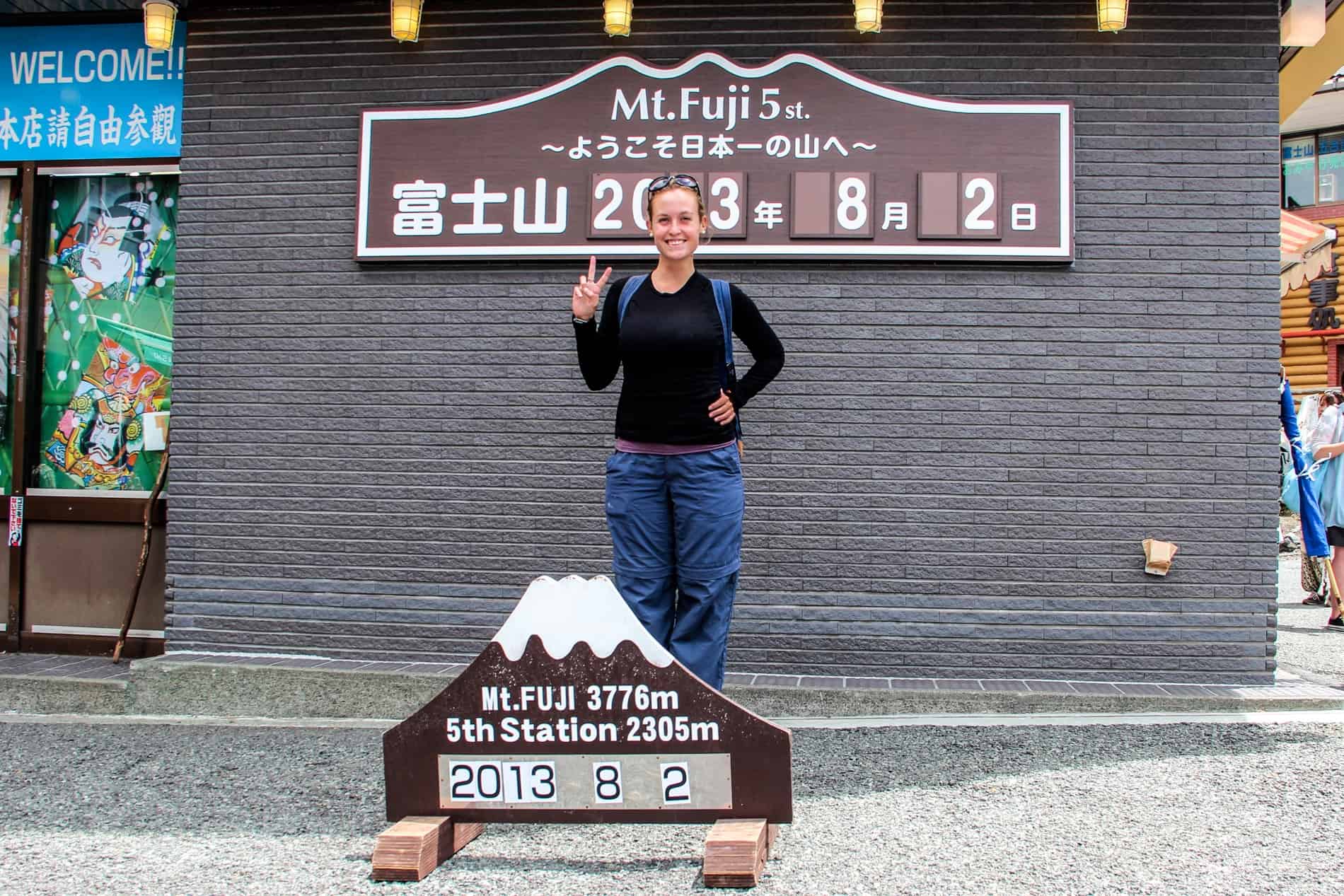
Rite of passage Fuji 5th Station sign photo.
Hiking the Yoshida Trail
Close-up, Fuji isn’t as attractive as she is from afar. The initial tree-lined paths slowly fade to charcoal-coloured gravel walkways and rocky walls of grey and horizon-hiding fog. You soon come to realise that the trek isn’t incredibly scenic.
Only then did I begin to appreciate the crowds, whose hues of yellow, green, pink and blue added saturation to an otherwise muted mountain canvas.
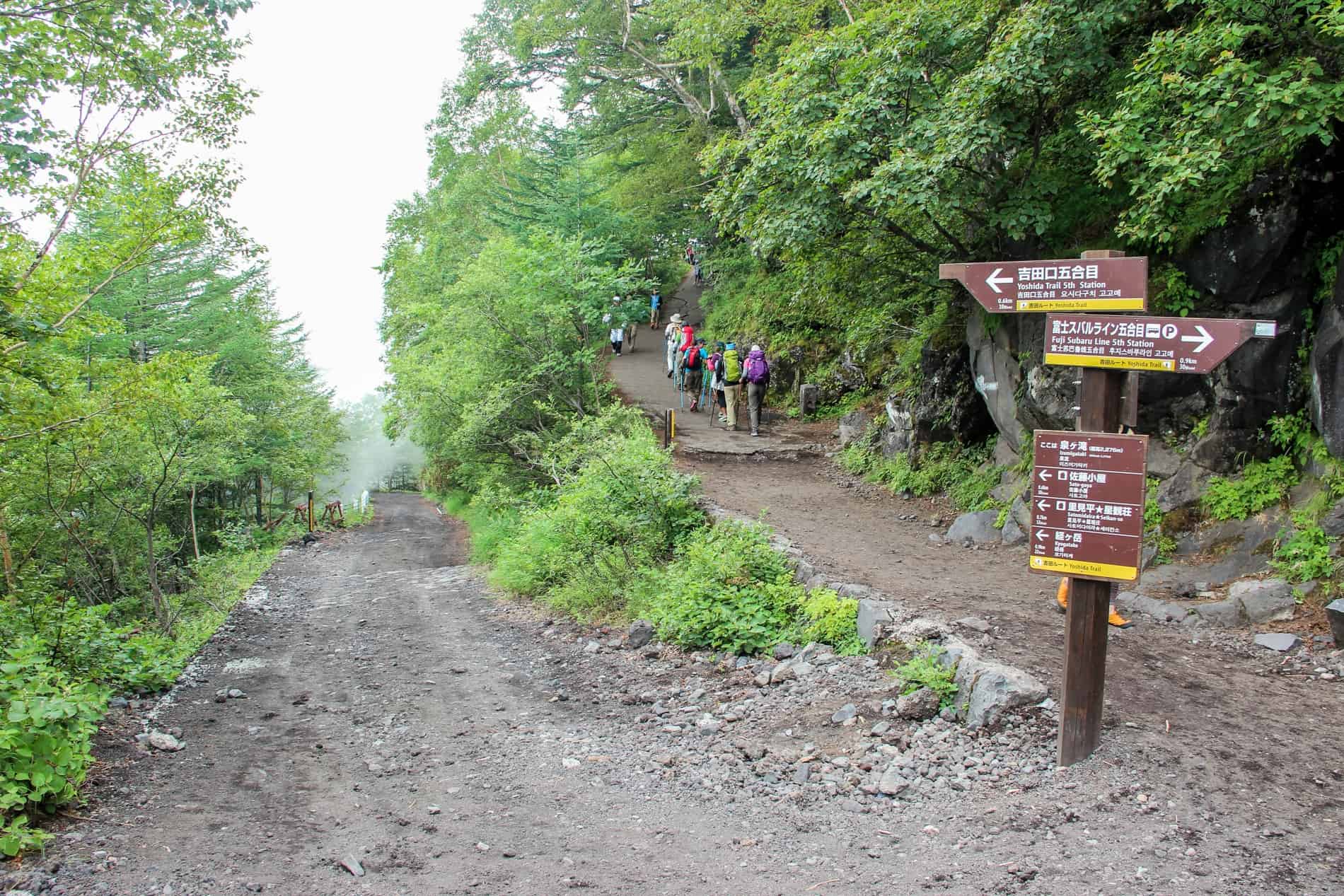
Mount Fuji’s signposed trails, with climbers following the Yoshida Trail.
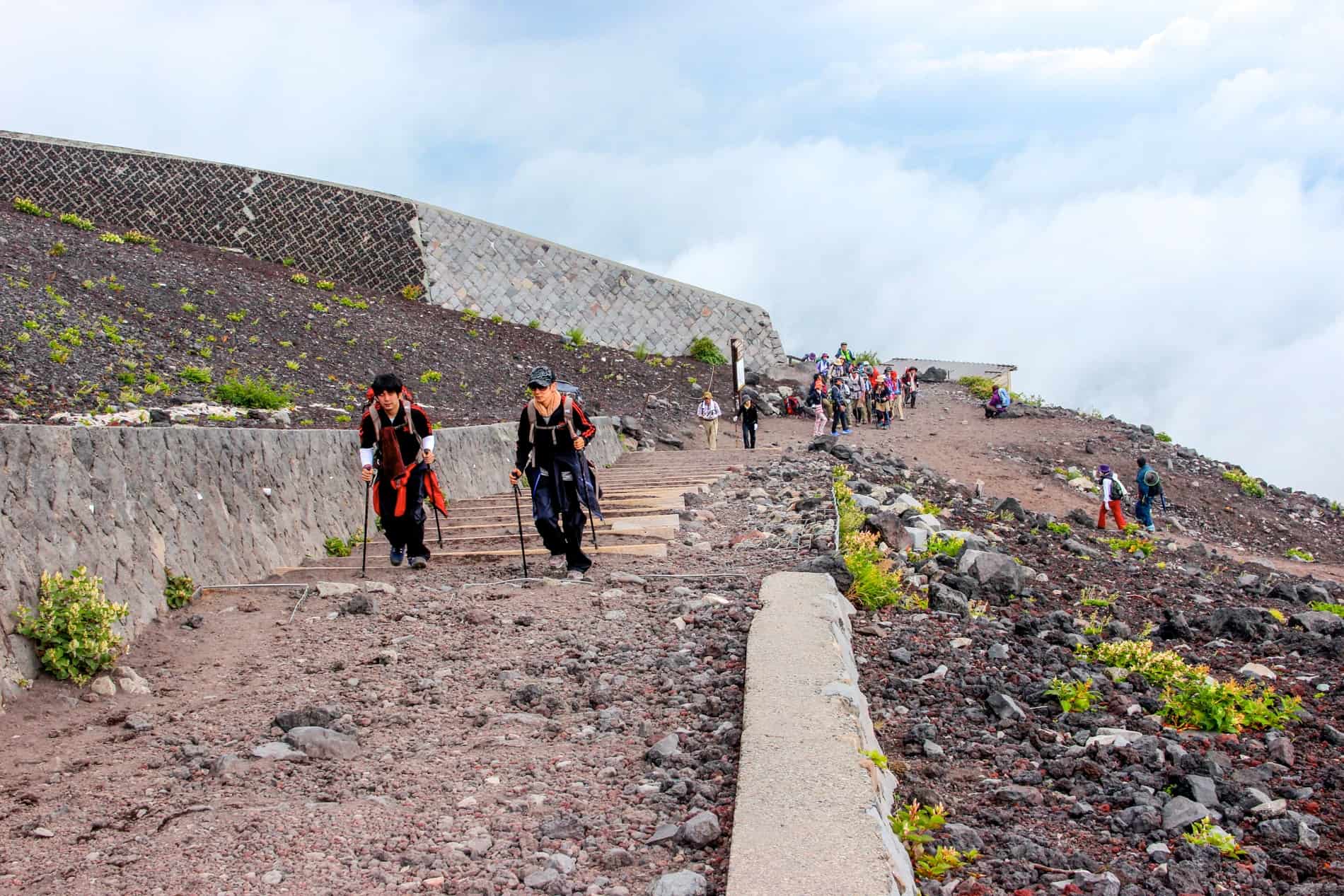
The steep inclines of the Yoshida Trail.
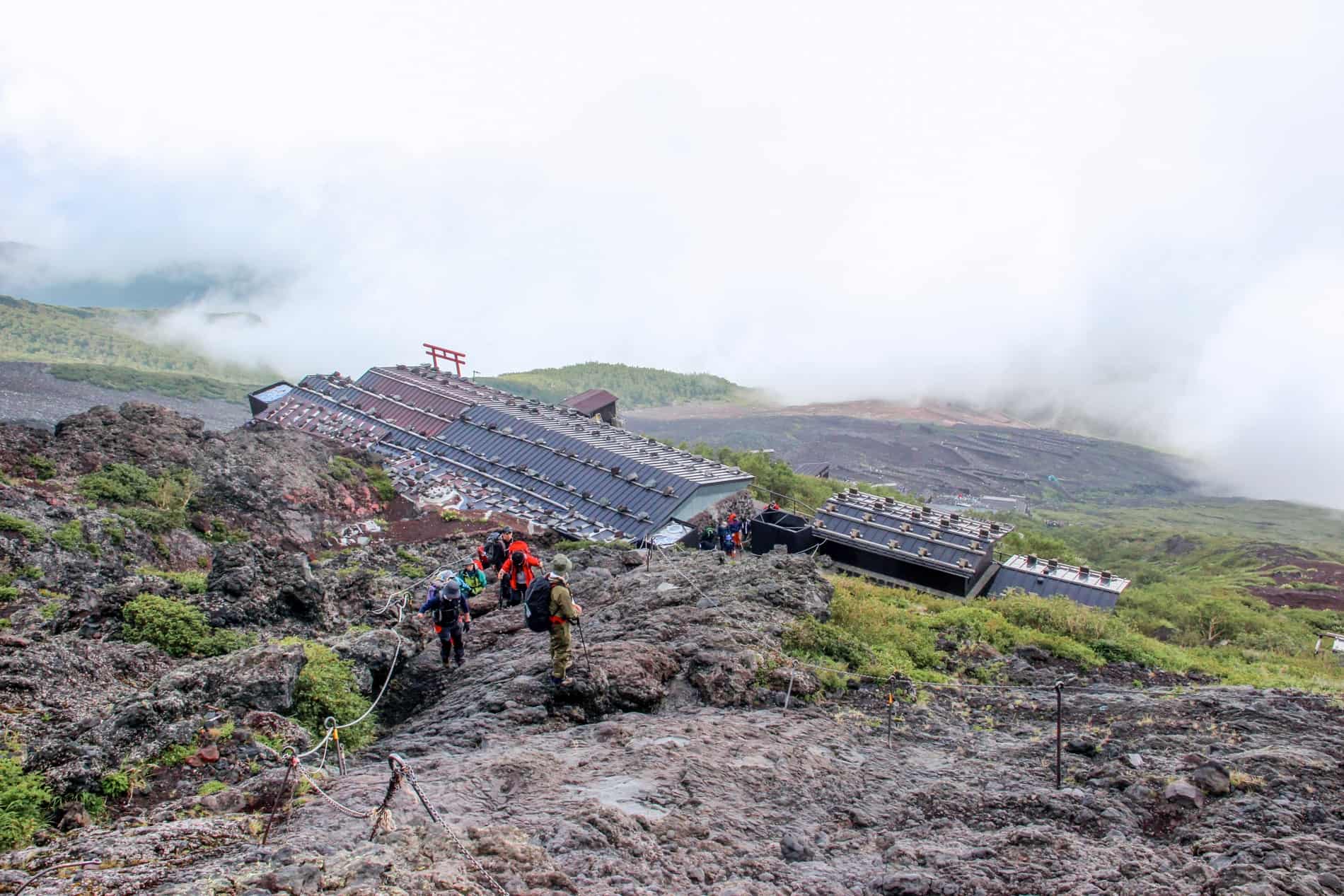
Zigzag trails and rocky climbs on the Fuji hike.
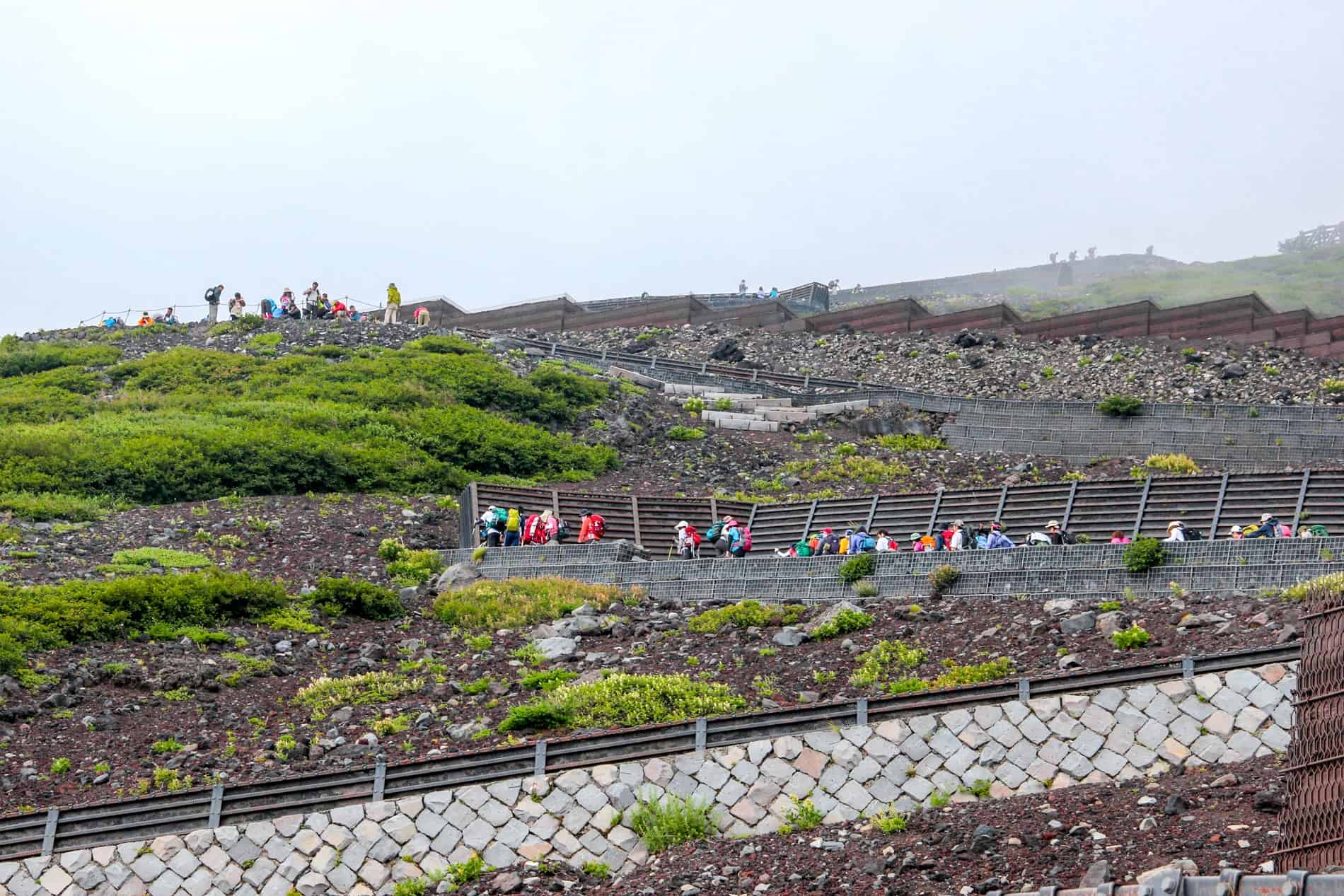
The colourful Fuji climber line.
Although you are only climbing around 1,500 metres from the 5th Station to the summit of Mount Fuji, it should be noted that during this approximate six-hour climb, you are climbing this height relatively quickly.
The climb is steep and strenuous in parts, and it’s only when you look down that you understand how sharp an incline you are on.

Taking it slow on the rocky paths.
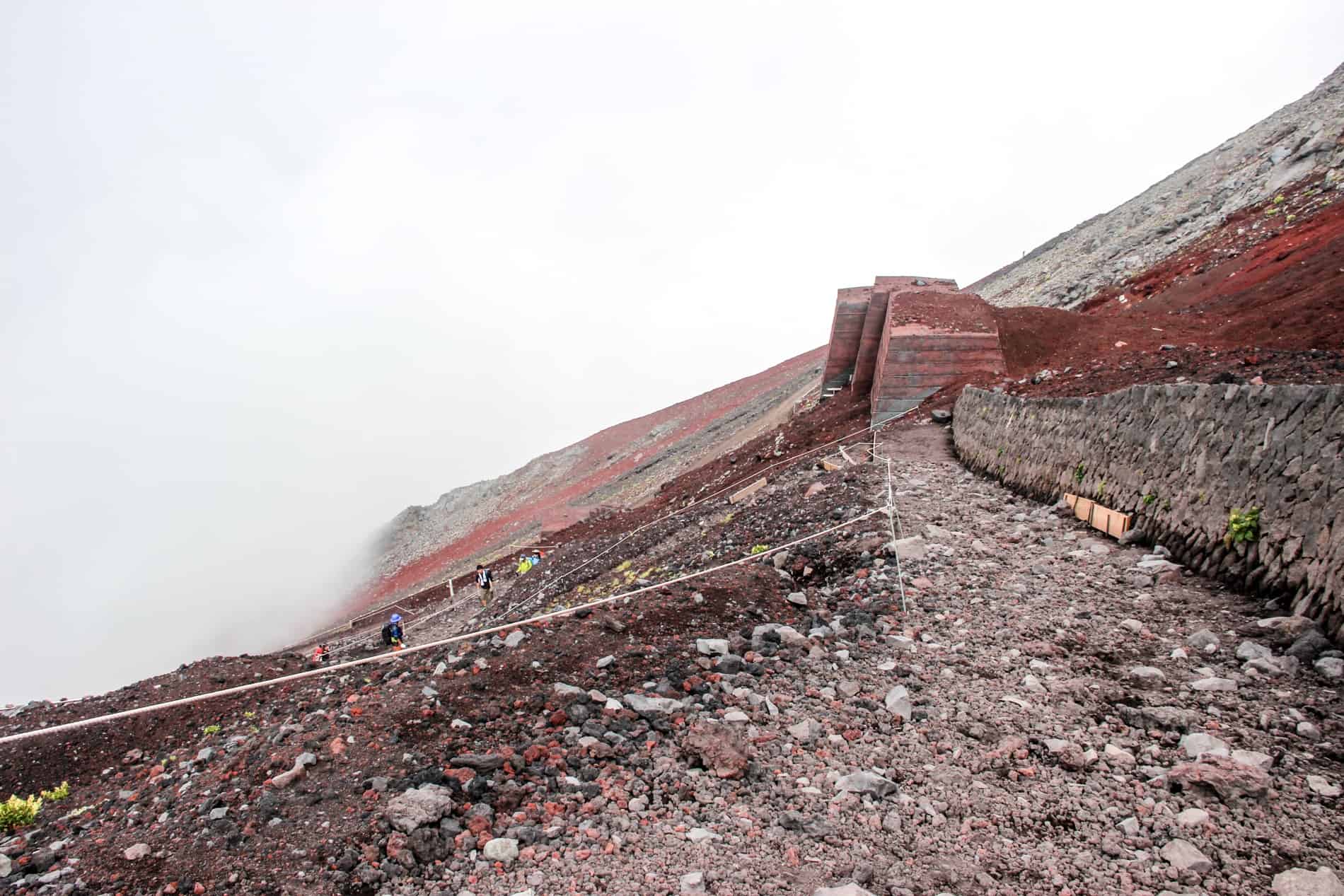
One of the sections of very steep incline on the Mt Fuji hike.
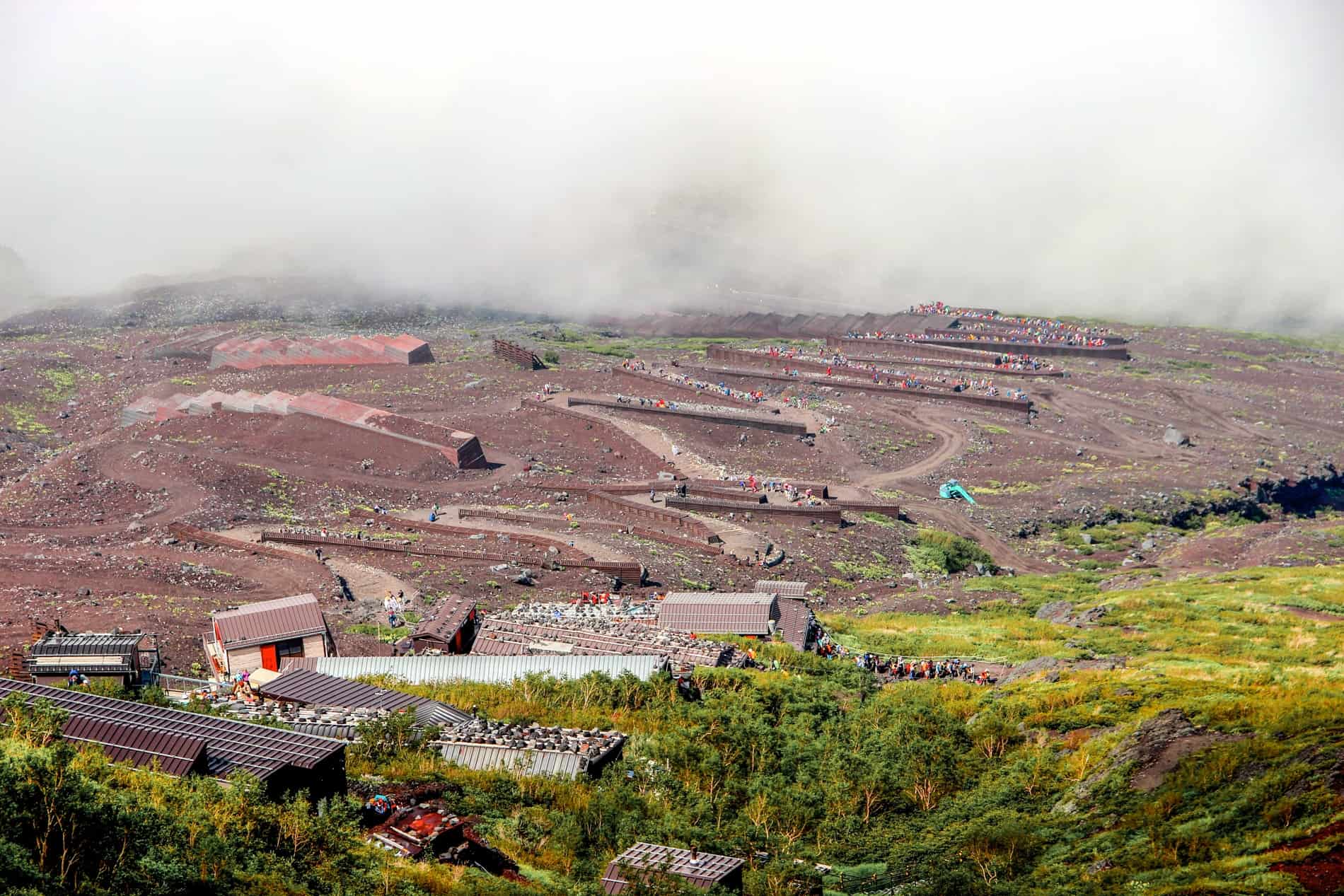
The long Mount Fuji climbing path journey between mountain stations.

What to expect on Fuji’s Yoshida trail.
A short climb does not mean you are not immune to the effects of altitude, which can kick in pretty rapidly.
I took short breaks when I reached every new mountain station; I factored in small stops for re-fuelling my energy with snacks; I walked at a slow and steady pace and drank lots of water; I did everything you are supposed to do.
Safety on Mount Fuji
The number one rule here is: you are responsible for your safety.
Altitude Sickness – What Do You Do?
The altitude hit me, and it hit me hard. Importantly, I didn’t succumb to buying a canister of oxygen and relying on it in an obsessive way like many Japanese were doing, which can dangerously mask the effects of altitude.
In most mountain climbing situations, such as during the Everest Base Camp trek, a person with obvious symptoms of altitude sickness is immediately taken down or stretchered down (if more of an emergency) to get them to a lower level of altitude to recover. Usually, you are advised not to continue with your trek.
I expected to be treated with the same immediacy – my mountain house was between the 8th and 9th Stations at 3250 metres – but that was not the case.
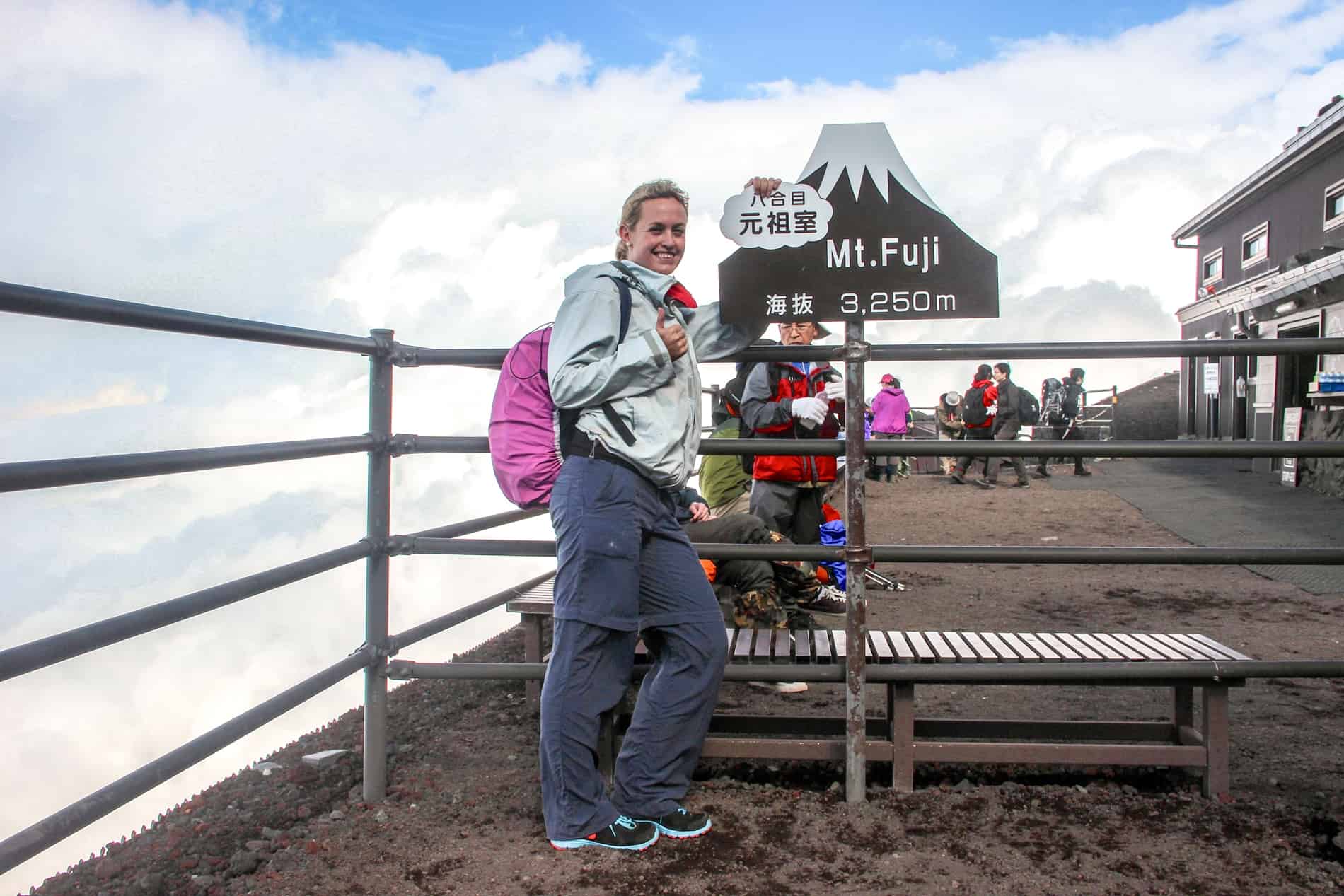
Arrival at a mountain house between the 8th and 9th Stations.

View over the Fuji Mountain Stations.
The first aid medical centre was on the 8th Station – not far. Yet not one member of staff would contact a doctor to see if I either needed help or if there was any way that I could be taken down (I saw cars). I managed to find a Japanese lady who spoke English, and she, too, tried to reason with them to no avail.
Instead, I was told to wait until sunrise as by then I would be fine, that the doctor was busy (even though they didn’t check), and to buy an expensive canister of oxygen to make myself better. I wasn’t even given a hot drink, and I was told I would have to pay insane prices if I wanted anything, including more water.
So while I spent the day leisurely climbing Mount Fuji, I was left for six hours in a dizzy haze, depleted of all energy and vomiting into a plastic bag.
So to that, I say be prepared. If you know you suffer from altitude sickness easily, take Diamox. Make sure you have painkillers. It seems it requires a lot to be able to get help getting down the mountain.
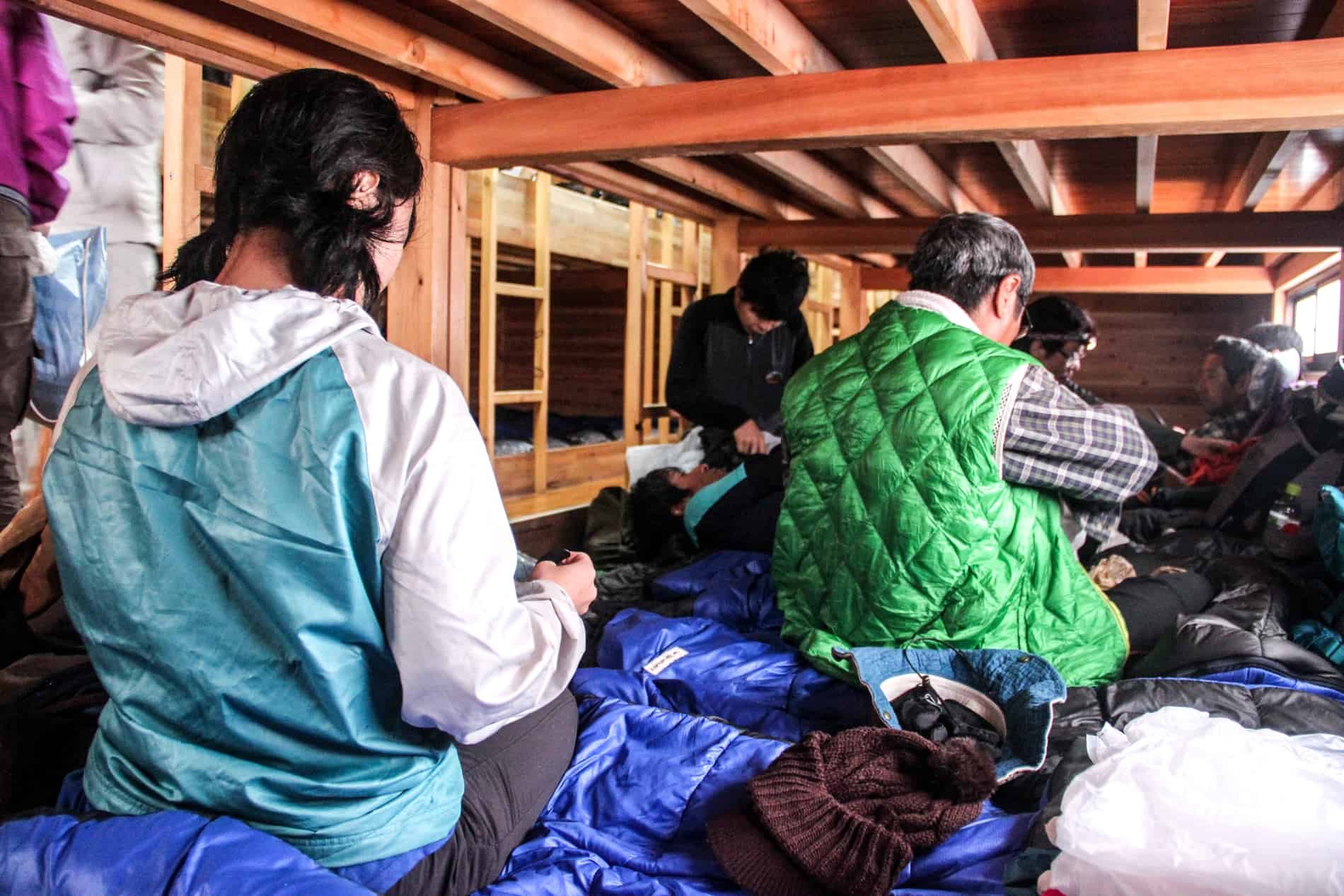
A typical communal sleeping area in a Fuji Mountain hut. Some do offer private rooms.
Climbing Plan Form
Something that wasn’t around when I climbed that has been implemented since is the compulsory Climbing Plan Form. This must be filled out and submitted before you ascend the mountain – it states the route you plan to take, who you are with and an emergency contact in case of search and rescue.
You then must wait to receive permission to climb Mount Fuji.
View rules, forms and guidelines.
Summiting Mount Fuji and Getting Down
Luckily, I had someone looking out for me – the Japanese lady wasn’t just my translator in a time of struggle, she became my friend. She promised me that she would summit Fuji and detour back to the mountain hut on the way down to pick me up.
I was awoken by the mountain house worker around 6 am. As he entered the room and aggressively pulled apart the curtains, and said bluntly: “Get up, it’s sunrise, you feel better”. I did feel better, but not that much, yet this was my cue to get out.
But the lady had kept her promise and was waiting for me. We talked and laughed down to the 5th Station, where we both sighed in relief and delighted at the finish.
I saw the sunrise over Mount Fuji through her photos as we ate ice cream – it was incredibly beautiful watching the sky change from dark blue to fiery red and then to clear blue sky above intense crowds of people.
Then she said to me: “I will never climb a mountain like this again. It was hard, and I didn’t enjoy it.”
“I’ll be back again one day”, I replied. “I’m not finished with it yet.”

The volcanic terrain of Mt. Fuji, Japan.
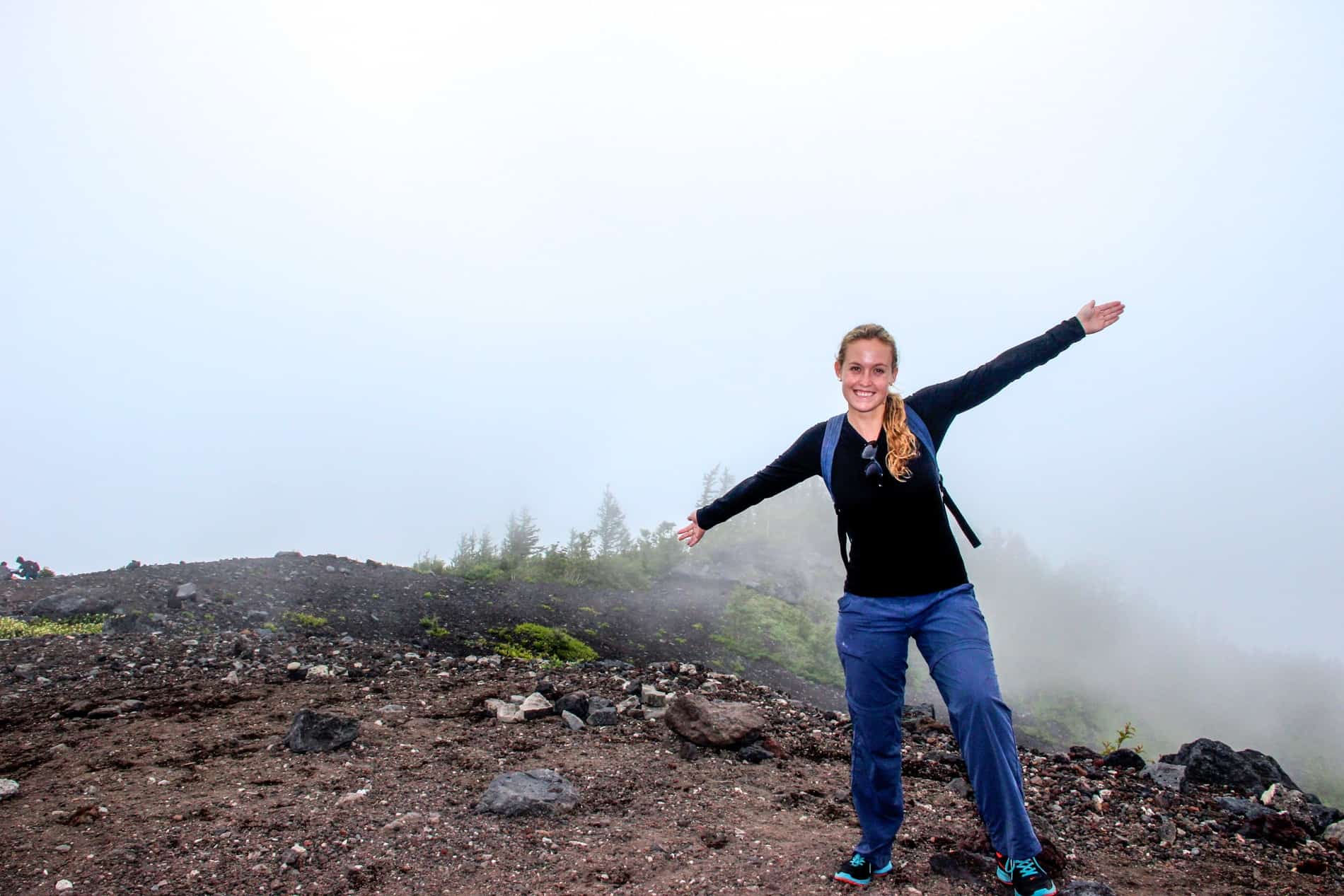
Mt Fuji views – expect a lot of fog.
Travelling in Japan
Is Mount Fuji just one of the many destinations on your Japan itinerary? From city-hopping to overall planning, check out my Japan articles for more inspiration.
- Starting from the Capital? Here’s what Tokyo is like.
- Trying to decide where to go and how to budget? Here’s the cost of a Japan trip.

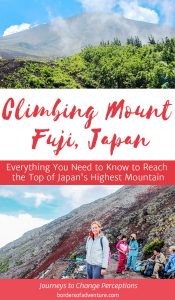

Carmel Hiker says
Recently (April, 2023) a friend asked me about the info on climbing Mt. Fuji. Since my climb to Fuji was 60 years ago, I started looking into the web . I am so glad I found your site; full of helpful information, lovely photos and your experience of friendship. Thank you for writing it up.
Marlina says
Thank you so much Becky for sharing your experience.
It’s good that I found you because I am traveling alone next week to Japan and was considering climbing Mt. Fuji, and the best part of the article for me was when you listened to your body and stoped climbing.
I think you were very wise to be honest with yourself… and that you are open to sharing it too. It’s not easy to accept defeat.
I am not an avid trekker, nor have the physical condition to endure so many hours of climbing, and after reading your story I have realized that I was blinded by the pictures of that wonderful sunrise, regardless of the suffering. Now my mind has changed and I will just enjoy the view of Mt. Fuji from the comfort of a nice place in the base and take it easy with myself, not pushing me to do things Im not ready to do.
All the best!
Marlina
Rana Singh says
Great article and wonderful pics. Japan really have some cool place. But thanx to the friendly Japanese people.
Thanx for sharing and Happy New Year.
Monica says
I can’t believe there weren’t any proper medics there to help you, I’m guessing that people suffer from altitude sickness all the time? I always expect epic treks to be loads of fun but in reality, they’re just hard work!
The only good part is looking back on them in 6 months time when you’ve forgotten all the pain and hard work.
Good on you for wanting to try again!
Becki says
Oh there was medics, just that my mountain house people couldn’t be bothered to call them out.
Treks are total hard work and the best bit is reaching summit and feeling the pain fade away. I guess it might be similar to having a baby…
Rashaad says
When I lived in Yamagata Prefecture, I climbed Mount Fuji roughly four years ago during 海の日 (Umi-no-Hi) Weekend. It was a bit more difficult than I expected. I didn’t help myself because I was a bit unprepared for the cold. I didn’t feel any altitude sickness – but mainly I felt uncomfortable due to the cold. I’m sorry we felt altitude sickness. Also, my friends and I climbed during the middle of the night, so we were a bit tired. We couldn’t book a hut on Fuji (They were all sold out well in advance), but we could relax in one for a couple of hours.
Anyway, climbing Fuji was an unpleasant experience – mainly due to the cold and the fact we couldn’t get any sleep. But I proud we climbed Mount Fuji since it was a goal of mine in Japan. Now we didn’t reach the summit – we roughly 100 meters from it. But since the line stopped moving, we dedided to just head back toward the bus. I am happy we climbed Mount Fuji because it was a challege.
That’s just my two cents about my Fuji experience.
Becki says
I met people who disliked it due to the cold and rain. I guess some people get lucky on Fuji!
Jaren says
Hey Becki,
Sucks you didn’t get to finish Fuji. If it’s any consolation, I wish I would have just stayed back. I had an awful experience too! This mountain is much prettier from afar, like you said! I hope you are feeling better now, and I have taken your advice on China several times. You were right: China is a little weird, but very exciting too! Hopefully we will cross paths again one day. You really gave me inspiration to continue writing and traveling when I was homesick. Thanks for great chatting at K’s House! Good luck on your next climb, wherever it may be.
Jaren
Becki says
Fuji certainly wasn’t what I had planned. Although I am not sure what’s worse… altitude sickness or the terrible weather conditions you had and being stuck outside! I’m sure our paths will cross soon. It’s crazy how small the world becomes 🙂
Steph (@ 20 Years Hence) says
I have a friend who lived in Japan for 2 years and she tried to do the Fuji trek but failed miserably as well too. Though in her case it wasn’t due to altitude sickness, but terrible weather instead. She and her hiking buddy made it up to a certain station and then a terrible lightning storm struck. All the huts were full so they wound up huddled on a bench all night waiting for the storm to pass and enough light to break so that they could make their way back down. After hearing her horror story (and now yours!), I have no desire to ever tackle Fuji-san!
Becki says
The huts wouldn’t allow people to sit inside…during a STORM?? That’s terrible. Just proves a point that the purpose of these mountain huts needs some assessment.
Ryan says
It is a damn shame that you had such a horrible experience at such a potentially amazing place. It is an even bigger shame that they treat climbers that way. I feel like it happens anywhere there is a large mountain to be conquered. That even though somebody could potentially be dying, they won’t help you unless you pay up. No care for the experience or another humans well being. What is a guide suddenly took a spill or felt sick? How would they feel if we said, “I’ll carry you down for $200”? Obviously that is unlikely to happen, but the extortion of places like this is sickening. Bummer you couldn’t make it this time, but there will be others to conquer!
Beth says
Sorry to hear about your bad experience! It actually really surprised me because I have had nothing but good experiences in Japan when it came to health issues.
I’m really hoping to summit Fuji next summer. We were there last April, so we could only go halfway… but it was super beautiful (kinda ugly in the summer with the lack of snow, don’t you think?) I hope you finally get the chance to summit as well!
Becki says
I had no other health issues in Japan, although this was purely altitude and not specifically anything to do with Japan.
I agree, it is slightly ugly up close… but you only go through this pain for the ultimate view. I’ve climbed mountains a lot more picturesque!
Tammy says
Oh dear that brings back memories of EBC. I was lucky to such a trouper of a guide who gave me soup, tea, a gazillion blankets and a hot water bottle. What you experienced is not nice and it must have been scary. I am glad the lady helped you the next morning though. I still haven’t gotten over the fact that I had to abandon my trek one day before reaching base camp. I think that’s what you call summit fever. I will be back one day as well I think! 🙂
Becki says
Glad you got excellent treatment…especially at EBC. And for wanting to try it again is brave.
Angela says
Altitude sickness is not fun. I did not have it to the degree you did, but it is not fun to hike when feeling a little off. One of my travels, we were not able to rock climb a route I had been training for because my climbing partner fell ill from the altitude. It is funny on how altitude affects everyone differently and in very different circumstances!
Becki says
It is indeed. It strikes without any warning… very scary!
Kellie says
That sounds like a horrible experience and its depressing to think that you were exploited when in such a vulnerable state.
I’m glad that it didn’t put you off though and that there was someone there kind enough to look out for you.
Becki says
I’m not too happy about it! But…the kindness of strangers always pulls through!
Kellie @ The Fundamental Alchemist says
Sorry you had such a rough time! I climbed Fuji at the end of July and coming back down really took it out of me. I climbed overnight so I could carry less water and the moonlight actually made the mountain look better than the sun did. The next morning it was cloudy so I never actually go to see Mt. Fuji although I felt like I’d been in a fight with it. Saw it from the shinkansen window once but each time I’m in the area (which is fairly often because I live here) it’s dressed in fog or clouds. I’m determined to get a photo before I leave!
Becki says
I bet it’s stunning at moonlight! I got a very foggy glimpse on land but have heard many friends try and fail at getting the ultimate snapshot. Seems like Fuji likes to hide a lot… At least you are there to keep trying!
Laura Emily says
So sorry to hear you suffered altitude sickness, that is awful! Hope you are feeling much much better now! Xx
Becki says
I was lucky and recovered within 24 hours. Just took me a few more days to get over the fact that I never got to summit!
Lesley Peterson says
Wow, what a cautionary tale! The Japanese government should be regulating what goes on in a national park or public area. There should be some equivalent to park rangers or mountain rescue, rather than just rude concession holders. You can’t be the only one who was ill treated at Gansomoro mountain hut. Hopefully their dissatisfied guests will spread the word on Trip Advisor and the government will yank their license to provide food/drink/so-called service. I’m not usually a complainer but when it’s a matter of life or death…!
Becki says
I agree. Altitude sickness needs to be taken VERY seriously and I am sure the people in the first aid station would have been more than happy to help me… if they were called. Surely, part of the job is to ascent or descent to get to people so the fact I was a little way up should not have mattered a jot. I need to have a dig around and see if anyone else has had a similar experience.
Ashley says
I know how you feel. I was lucky enough to have gone with a group of friends just yesterday. Climbing the mountian was very enjoyable, and I had read your experience before going, so while we had a can of oxygen for emergencies, I would not use it for anything but. My group stayed at the hut that was 3,450 meters up. I only developed symptoms of bad altitude sickness at around 12 am after failing for so long to get some sleep. My friends wanted me to wait until the sun rose to go, but they did not take long to convince that I needed to decend. I was rather more lucky that I did not wait until vomiting to insist on going down. One friend asked the person in charge of the hut about it, and came back convinst that I had to go down immediately, which was also very lucky for me. Three helped me get down about 50 or some meters, and one stayed with me to take me all the way down. I’m very greatful that they took me seriously when I said that I needed to go down.
Becki says
I’m so glad that your mountain hut people looked after you and listened to you, as well as helping you descend. What was the name of the hut you stayed in? Always good to pass on the info for others.
Ashley says
We stayed in Goraikoukan. The highest possible mountain hut on Mt. Fuji.
Ashley says
We stayed in Goraikoukan, which is the highest possible mountain hut on Mt. Fuji.
Ashley says
Sorry about that, it said the original was deleted. Anyway, I possibly had HAPE, but I dismissed my first symptoms as difficulty with asthma. I waited about an hour with shortness of breath, only using the Oxygen once, still not thinking it was too serious. It wasn’t until the headache hit me and kept getting worse and worse that I knew I could not wait any longer. By the time my friends and I were ready with our belongings to descend, I was a bit confused and not helpful at all. It wasn’t the mountain hut people that helped me down though, but three of my friends. I was nearly entirely dependent on my friends on the way down, especially at first. Once I started becoming a little less lethargic, two went back up to summit the mountain with the rest of our friends.
Jimmy Dau says
Sometimes you just can’t argue with your body. Shame about the house worker though but it looks like you made new friends as a result through the Japanese lady. Japan is such a special place
Helen says
Hey Becki,
I climbed Kili and I was bad with altitude sickness too. I did make it to the top, but I probably shouldn’t have and I’m still not quite sure how I did it. I barely ate for a week and lost a stone in weight!
That’s the problem with climbing quickly, altitude sickness is much more likely to hit you than if you’re going higher, but going slower over and longer period of time! You made it to Everest Base Camp so you know you can do it under the right circumstances.
So glad that you still want to do it!
x
Becki says
I think the quick ascent really has a lot to do with it. Plus I wasn’t at my absolute best so maybe should have left it another day or too. Still, you can’t help what happens can you? You lost a stone climbing Kili? Wow. Was that a part of the sickness? I will be back for sure.
Jennifer says
Thank God for the kind Japanese woman so at least you had someone to watch over you on the way down. The people at the mountain hut sound like, pardon my French, complete assholes!
Becki says
I can’t speak for the other mountain huts but I certainly hope they are not similar!
dsds says
I have to concur with the thrust of this article. The people running the ‘huts’ on the mountain have been the most vile, opportunistic people i have ever met in a camping/hiking venue. This is a marked departure from all my other experiences in Japan, where the people were quite gracious.
Fuji is run by an ostensible ‘nature’ organization. However, the whole thing is run to screw people over. Huts are 70 dollars plus/person. By hut, im talking about sleeping on a wooden log, no cushion, heating, insulation, with 70 other people. The stench of CO2 is overwhelming. Freeze dried noodles cost ten dollars. Oxygen is unnecessary but also paid for a premium. The worst gauge is a pay toilet, permanently manned by a woman. I asked one of the hut Japanese men about the sanitary conditions with pay toilets; he just walked away. I was actually kicked out of the hut after paying into well below freezing temperatures because I refused to move my space on the log without making an angry face. I promptly banged my stick, looking into the small Japanese hut men faces as I left.
The hut people, which have a monopoly on Fuji, get away with such shitty behavior because Fuji has a religious meaning to Japanese, particularly seeing the rising sun. It would be smart to get to Fuji in the morning, climb up, and get down, thus avoiding altitude sickness, which is most pronounced during sleeping in the horizontal.
Instead, the earliest bus arrives after noon at the fifth station, making it impossible to make the last bus at 5 pm, so you are stuck with the huts. The huts are so unsanitary and offer no facilities, I would just skip them altogether.
If you are to be smart, I would just take the train out-of-Tokyo, staying at a cheap hotel in the town at the foot of the mountain. Get up early, take a cab (should be cheap with four people), get to the fifth station, have plenty of time to climb and get back down. It is cheaper and you can avoid the whole hut fiasco. Even though exhausted, I did not get one minute of sleep in the hut.
If one must see the sunrise, then take the cab late in the day, like 11 p.m., get to the fifth station, then walk-up. Sunrise is early but freezing. I actually slept on a picknick table on the summit (way better than the hut); however, my body temp went way down, forcing me to buy some pig fat soup at 20 dollars a bowl…. It saved my life, however, as I was too tired from the hut experience (the actual climb is easier for any Boy Scout level hiker) and the lack of sleep.
Fuji could be a great experience, but avoid the huts. I was actually kicked out on both occasions I stayed there: one for ‘rudeness’ the other when everyone was unceremoniously kicked about because of a ‘typhoon’. I actually didnt care and just wanted out after the hut experience, and the company’s poor treatment of hikers.